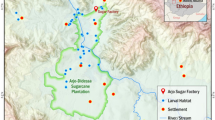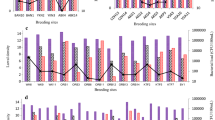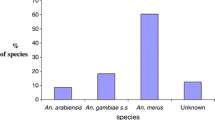Abstract
A year round study was conducted in Trivandrum city during the period of March 1984 to February 1985 to elucidate the relation between certain physico-chemical factors and seasonal density ofMansonia larvae (Culicidae: Diptera).Mansonia uniformis was found to be the predominant species during this period, whereasMansonia annulifera was less than 10% of the totalMansonia collected. The period of high prevalence was found to be January–March. Out of the 6 physico-chemical factors studied Na+, K+, and pH showed statistically significant correlation with the larval density, while Ca++, Mg++ and rainfall showed no significant relation.
Similar content being viewed by others
References
American Public Health Association 1960Standard methods for the examination of water and waste water including bottom sediments and sludges, 11th edition (New York) p 626
Burton G J 1959 Studies on the bionomics of mosquito vectors which transmit filariasis in India; 1. Attachment ofMansonia annulifera andMa. uniformis larvae to host plants occurring inPistia tanks in Kerala, South India;Indian J. Malariol. 13 1–41
Chandrasekharan A, Das M, Krishna Rao K H and Rao C K 1976 Pilot project for control ofBrugia malayi filariasis Part 1; Some aspects of bionomics of vectors;J. Com. Dis. 8 179–188
Daniel B Ayyachamy, Cherian Thomas, Kalyanaraman K and Prasad R S 1986 Seasonal prevalence and host visitation ofMansonia mosquitoes in Trivandrum City with a note on mite infestation;Proc. Indian Acad. Sci. (Anim. Sci.) 95 475–485
De-Alwis R E and Munasinghe C H 1971 Hydrogen ion concentration in breeding habitats ofCulex pipiens fatigans (Wied) and associated mosquitoes;Bull. WHO 45 853–854
Gillet J D 1971Mosquitoes. (London: Widenfield and Nicholson) p 274
Hangstrum D H and Gunstream S E 1971 Salinity, pH and organic nitrogen of water in relation to the presence of mosquito larvae;Ann. Ent. Soc. Am. 64 465–467
Iyengar M O T 1938 Studies on the epidemiology of filariasis in Travancore;Indian J. Med. Res. Mem. No.30 pp 1–179
Jaswant Singh, Krishnaswamy A K and Raghavan N G S 1956 Filariasis in Travancore state, Shertallai Taluk;Indian J. Malariol. 10 317–325
Joseph C, Menon M A U, Unnithan K R and Raman S 1963 Studies on the comparative hospitality ofSalvinia auriculata Aubet andPistia stratiotes Linn toMansonioids annulifera (Theobald) in Kerala;Indian J. Malariol. 17 311–332
Kaul H N, Wattal B L and Sinha P 1977 Chemical characteristics ofCulex pipiens fatigans breeding waters in area around Delhi;J. Com. Dis. 9 8–21
Khamala P M C 1971 The biting flies of Kano plains, Kenya: Part II. Larval habitats of common mosquito species (Diptera: Culicidae);Bull. Entomol. Res. 61 299–307
Nair C P 1962 Filariasis in Kerala state Part VII: Survey of Ponnani (Palghat District):Indian J. Malariol. 16 47–62
Nair C P and Roy R 1958 Filariasis in Kerala state Part IV: Filariasis survey of Eriyad Panchayat, Crangannoor taluk;Indian J. Malariol. 12 195–201
Pal R, Nair C P, Ramalingam, Patil P V and Baboo Ram 1960 On the bionomics of vectors of human filariasis in Ernakulam (Kerala);Indian J. Malariol. 14 595–604
Sarkar P K, Rao K M, Mishra J N and Malhothra P R 1978 Seasonal incidence ofCulex pipiens fatigans Wied breeding Tezpur (Assam);J. Com. Dis. 10 212–217
Sehgal S S and Pillai M K K 1970 Preliminary studies on the chemical nature of mosquito breeding waters in Delhi;Bull. WHO 42 647–650
Sinha V P 1976 Further observations on the physico-chemical factors of the breeding places ofCulex quinquefaciatus say (=fatigans Wied);Mosq. News 36 358–360
WHO 1975Manual on Practical Entomology in Malaria prepared by WHO division of Malaria and other Parasitic diseases Part II:Methods and techniques; WHO Offset publication No 13, Geneva
Author information
Authors and Affiliations
Rights and permissions
About this article
Cite this article
Sasikumar, P.S., Suryanarayanan, P., Thomas, C. et al. Influence of certain physico-chemical factors upon the larval population ofMansonia mosquitoes (Culicidae: Diptera) in Trivandrum city, India. Proc. Indian Acad. Sci. (Anim. Sci.) 95, 549–555 (1986). https://doi.org/10.1007/BF03179417
Received:
Issue Date:
DOI: https://doi.org/10.1007/BF03179417




